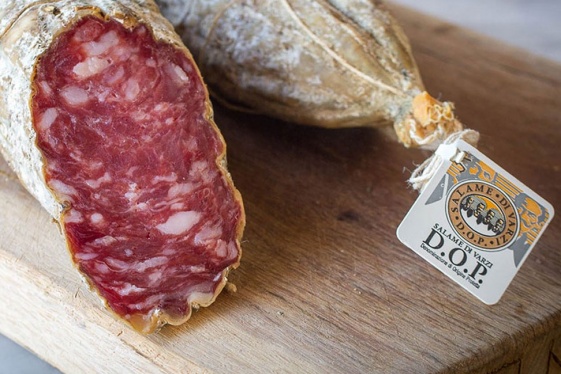
MIPAAF
The Ministry of Agriculture and Forestry (Ministero delle Politiche Agricole Alimentari e Forestali – MIPAAF) develops and coordinates the lines of agricultural, forestry, agri-food and fisheries at the national, European and international level. http://www.politicheagricole.it/
Italian flavors: Valtellina Bresaola
The earliest literary evidence of the production of Bresaola della Valtellina dates back to the 15th century, but the origin of this typical salami certainly pre-dates that. It is linked to the ancient tradition, common throughout the Alps, of preserving meat by salting and drying. However, the cool, dry and well-ventilated climate of Valtellina al...
Italian flavors: Cremona Salami
Its precise origins are unclear, but salami making has certainly been closely associated with the presence of numerous pig farms in the Po Valley since Roman times. Pig farming and the marketing of pork products acquired a central role in the rural economy and the daily life of the local communities at that time, a fact testified by numerous codex...
Italian flavors: Thorny artichoke from Sardinia
The artichoke is a vegetable native to the Mediterranean basin and the first evidence of its consumption as food dates back to the Egyptian and Greek civilisations. In the fourth century BC, Theophrastus mentions it in his history of plants. It was also cultivated in the Roman period, as noted by the historians Pliny and Columella. Over the followi...
Italian flavors: Tuscan pecorino
Pecorino is an exquisite product with a long tradition. Ancient testimonies still exist that praise its qualities: in older times it was called “Marzolino” and in 1475 the humanist Bartolomeo Platina acclaimed it as the best cheese in Italy. In 1832, Ignazio Malenotti, a member of the Linnean Society of Paris, published the “Shepherd’s Handbook” in...
Italian flavors: Murazzano Cheese
Murazzano DOP (Protected Designation of Origin) is the oldest and most delectable of the robiola cheeses from Piedmont, and is made using methods and tools that follow a now-established tradition. The origins of the Tuma cheese from Langhe Cuneesi date back to antiquity and are interwoven with the roots of the history of the Municipality of Murazz...
Italian flavors: Dauno Oil
The history of the olive has been linked to that of humanity for over 7000 years, even becoming a biblical symbol of peace between God and humanity after the Flood. Olive oil originated in the Eastern Mediterranean and has been used in various ways over the centuries: as an ingredient in cosmetics, a medicine, a fuel, an element of religious ritual...
Italian flavors: Buffalo mozzarella
The origins of this cheese are directly linked to the introduction of buffaloes to Italy: according to one of the most credible suggestions, it was the Norman kings who promoted buffalo farming in Southern Italy, in around 1000 AD, beginning from Sicily, where the animals had been originally introduced by the Arabs. Used initially as working animal...
Italian flavors: Sila potato
Originally from Peru, the Patata della Sila was introduced by the Spanish, who first brought it to Galicia and then their domains in Italy. From here, it began to spread throughout all of Europe in the sixteenth century. Native to the Andes, the Patata della Sila is particularly suited to high altitudes and sloping fields. The cultivation of the P...
Italian flavors: Gorgonzola
Gorgonzola is a very old cheese, but its origins are shrouded in legend mystery: F. Massara, a historical writer of chronicles, believed that gorgonzola should be considered a refinement of the cheese that Ansperto da Biassono, archbishop of Milan from 868 to 881, mentioned in his will. Others claim that gorgonzola was first made in the town of the...
Italian flavors: Calabria Clementine
A cross between bitter oranges and mandarins, Clementines may have originated from Algeria. According to one of the most credible hypotheses, their name refers to Father Clément Rodier on Misserghin, who grew them in his orchard. Though grown in Italy since the 1930s, it was in 1950 that its cultivation became widespread in Calabria, where it foun...
Italian flavors: Varzi Salami
The production of salumi (cured meats) was introduced to the Staffora Valley and the surrounding area by the Lombards, who settled there in the Dark Ages. The Lombards had learned how to consume ground animal meat without cooking it from the Tartars, thereby testing out the first procedures for the production of sausages. Cooking fires were not nee...
Italian flavors: Fontina
The history of Fontina is linked to the history of its name. The name Fontina is frequently mentioned in ancient documents on the Aosta Valley. References to the “De Funtina” family can be found from the mid-13th century and “de Fontines” appears a hundred years later. There are abundant references to the use of Fontina as a place name for meadows,...














